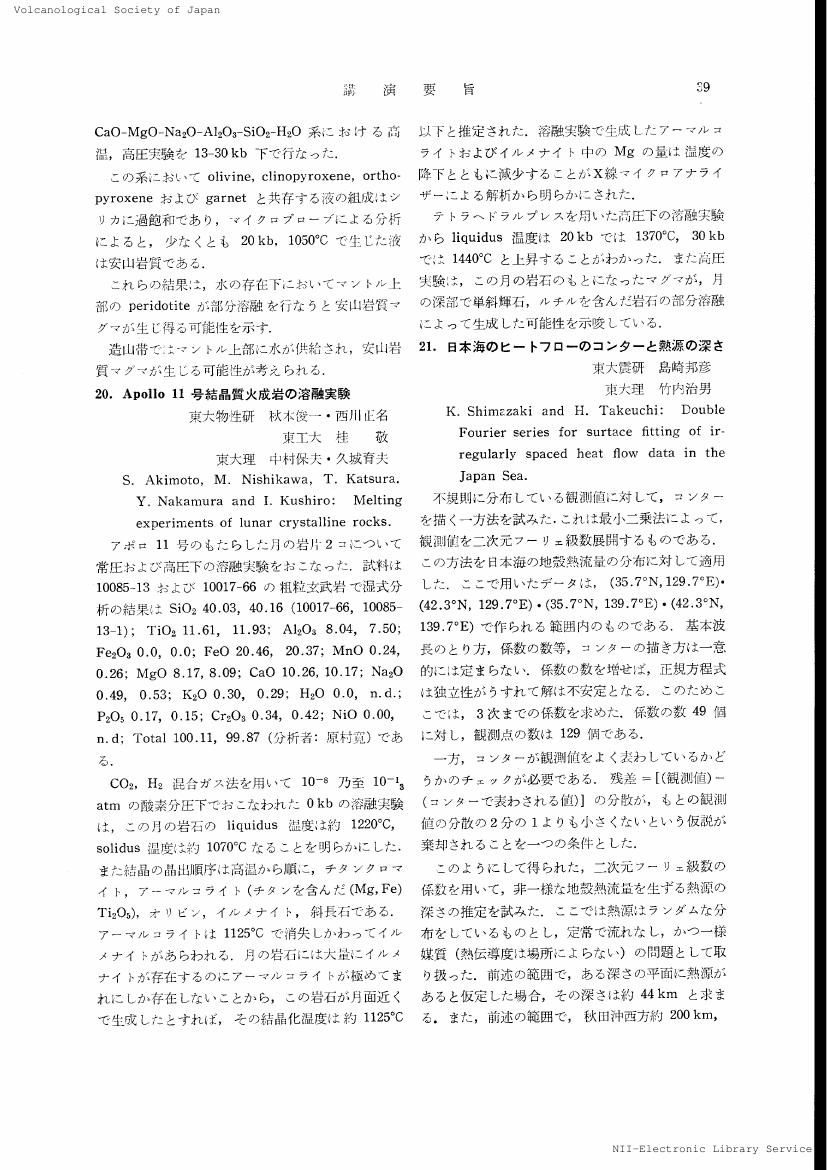1 0 0 0 OA 永田武先生をお偲びして
- 著者
- 秋本 俊一
- 出版者
- 一般社団法人 日本物理学会
- 雑誌
- 日本物理学会誌 (ISSN:00290181)
- 巻号頁・発行日
- vol.47, no.7, pp.588-589, 1992-07-05 (Released:2020-03-04)
1 0 0 0 箱根・伊豆地方の古地磁気学
- 著者
- 秋本 俊一 西川 正名 桂 敬 中村 保夫 久城 育夫
- 出版者
- 特定非営利活動法人 日本火山学会
- 雑誌
- 火山.第2集 (ISSN:24330590)
- 巻号頁・発行日
- vol.15, no.1, pp.39, 1970-04-01 (Released:2018-01-15)
1 0 0 0 OA 高温下の圧力較正
- 著者
- 秋本 俊一
- 出版者
- 一般社団法人 日本高圧力技術協会
- 雑誌
- 高圧力 (ISSN:21851662)
- 巻号頁・発行日
- vol.9, no.3, pp.2386-2390, 1971-05-25 (Released:2010-08-05)
- 参考文献数
- 12
1 0 0 0 永田武先生をお偲びして
- 著者
- 秋本 俊一
- 出版者
- 一般社団法人日本物理学会
- 雑誌
- 日本物理學會誌 (ISSN:00290181)
- 巻号頁・発行日
- vol.47, no.7, pp.588-589, 1992-07-05
1 0 0 0 OA 第四紀の古地磁気学
- 著者
- 永田 武 秋本 俊一 上田 誠也 清水 吉雄 小島 稔 小林 和男
- 出版者
- Japan Association for Quaternary Research
- 雑誌
- 第四紀研究 (ISSN:04182642)
- 巻号頁・発行日
- vol.1, no.1, pp.7-10, 1957-05-30 (Released:2009-08-21)
A palaeomagnetic study has been conducted of the volcanic rocks in the North Izu-Hakone volcanic region, Japan, where the complete succession of lavas has been determined by H. Kuno. By sampling 4∼7 oriented rock-specimens at each of the localities, the period from the very beginning of the Pleistocene to the Holocene has been covered, where the maximum time interval between consecutive samples may probably be not more than several tens of thousands years except that between two samples of middle to younger Pleistocene when the volcanic activity did not occur within the region concerned. Care was taken not to use the rock samples of which natural remanent magnetization may have suffered from any significant disturbances, geologically, chemically, magnetically or otherwise. Selection of proper samples was performed according to the criteria for the stability of remanent magnetization proposed by us previously (Journ. Geomag. Geoelec., VI, No.4). The major findings in this study are: 1) During the whole Quaternary age, the axis of the geomagnetic centred dipole was fluctuating around an axis of which north pole changed from φ=72°N, λ=86°E to φ=81°N, λ=32°W. 2) The direction of polarization of the centred dipole was reversed at a time in the earliest Quat rnary, namely, during the middle period of the formation of the Usami volcano.
1 0 0 0 20G-5 Ilmenite型化合物の磁性
- 著者
- 石川 義和 永田 武 秋本 俊一
- 出版者
- 一般社団法人 日本物理学会
- 雑誌
- 日本物理学会年会講演予稿集
- 巻号頁・発行日
- vol.12, 1957
1 0 0 0 OA TiFe_2O_4-Fe_3O_4系の磁性とその酸化による変化 : XVII. 磁気
- 著者
- 秋本 俊一 永田 武
- 出版者
- 一般社団法人 日本物理学会
- 雑誌
- 日本物理学会春季分科会講演予稿集 昭和34 (ISSN:24331120)
- 巻号頁・発行日
- pp.226, 1959-03-31 (Released:2018-03-29)
1 0 0 0 16E13 自然産、〓磁性酸化金属の磁性について
- 著者
- 永田 武 秋本 俊一 上田 誠也
- 出版者
- 一般社団法人 日本物理学会
- 雑誌
- 日本物理学会年会講演予稿集
- 巻号頁・発行日
- vol.8, pp.12-13, 1953



